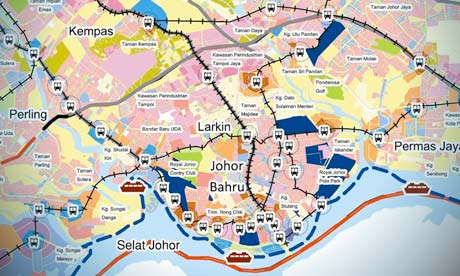Iskandar Malaysia - the green mega-city rising above Singapore
Planned eco-city for 3m people matches Luxembourg in size and showcases urban 21st-century smart living, say developers

Proposed map of the new eco-city Iskandar Malaysia.
Standing opposite Singapore, across the strait of Johor, is the site of a new project that its architects and developers hope will be the future of urban life in south-east Asia – a mega-city built along eco-friendly lines, with green energy and an end to the pollution that afflicts so many of Asia's cities.
Occupying an area the size of Luxembourg, the site is expected to have a population of 3 million by 2025, living as an ultra-modern "smart metropolis". Energy will be provided from renewable sources, transport will be publicly provided, waste will be diverted to other uses, and the city is planned by the Malaysian government as a showcase to be copied on a bigger scale across the region.
The world's urban population overtook the number of rural-dwellers for the first time in 2007, and future population growth in south-east Asia –at least 9bn people are expected to inhabit this planet by 2050, up from 7bn at present – is expected to be mainly in cities in the developing world. By far the greatest growth will be in slums, by current estimates.
Iskandar Malaysia offers an alternative. The plans are for a city that not only incorporates the latest in environmentally friendly technology, but that is designed for social integration. Green spaces and areas where people can mingle and relax will improve people's mental wellbeing and encourage social cohesion, it is hoped. Skyscrapers will be mixed with low-rise buildings and small self-contained "neighbourhoods".
Najib Razak, prime minister of Malaysia, said in a speech: "Iskandar Malaysia [is] a smart city template – protecting the environment, promoting equitable development and addressing urban development challenges [through] the creation of smart, liveable urban communities that will yield an improved quality of life for thousands of citizens, with safer, cleaner, healthier, more affordable and more vibrant neighbourhoods, serviced by more efficient and accessible transportation systems – great destinations for businesses."
Ellis Rubinstein, president of the New York Academy of Sciences, which is working on the "edu-city" university campus area, said it could be "a model to countries needing to accommodate the social and economic needs of fast-rising populations and environmental challenges".

No comments:
Post a Comment